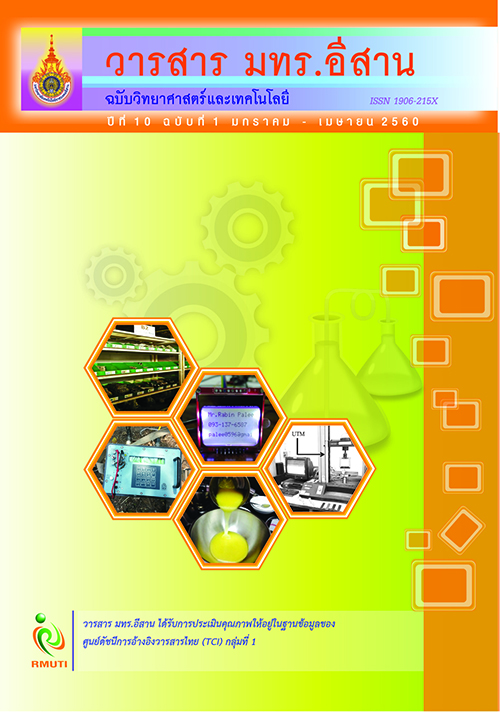การศึกษาแรงดันในการอัดเพื่อการผลิตก้อนเชื้อเพลิงชีวมวลจากเศษลำไย เหลือทิ้งที่ผสมด้วยเศษชีวมวลเหลือทิ้งต่างชนิดกัน (The Study of Compaction Pressure for Biomass Briquette Production from Longan Waste Residue Mixed with Different Biomass Residues)
Main Article Content
Abstract
บทคัดย่อ
ก้อนเชื้อเพลิงชีวมวลเป็นหนึ่งในทางเลือกของการค้นหาพลังงานทดแทนที่เหมาะสมสำหรับประเทศ
เกษตรกรรม เช่น ประเทศไทย วัตถุประสงค์ของการวิจัยนี้มุ่งเน้นไปที่การผลิตก้อนเชื้อเพลิงชีวมวล
จากเศษลำไยเหลือทิ้ง (LR) โดยศึกษาที่แรงดันเพื่อใช้ในการอัดก้อนชีวมวลที่ 4.5 6.0 และ
7.5 เมกะปาสคาล และเลือกใช้ชีวมวลเหลือทิ้งที่นำมาเป็นส่วนผสมแตกต่างกัน 2 ชนิด ได้แก่ เศษไม้ไผ่
เหลือทิ้ง (BR) และกากกาแฟ (CR) ซึ่งใช้แป้งเปียกเป็นตัวประสาน ผลการศึกษาพบว่า ก้อนเชื้อเพลิง
ที่ผลิตจากส่วนผสมของชีวมวลต่างชนิดกันต้องใช้แรงดันและปริมาณตัวประสานแตกต่างกัน โดยพบว่า
ก้อนเชื้อเพลิงที่ใช้แรงอัด 6.0 เมกะปาสคาล ซึ่งผลิตจากเศษลำไยเหลือทิ้งผสมกากกาแฟ (BQ7)
มีความหนาแน่นสูงกว่าก้อนเชื้อเพลิงที่ผลิตจากเศษลำไยเหลือทิ้งผสมเศษไม้ไผ่ (BQ1) แต่ใช้ปริมาณ
ตัวประสานมากกวา่ คอ่ นขา้ งมาก สว่ นกอ้ นเชื้อเพลิง BQ1 พบวา่ มีสมบัติทางเคมีและทางเชื้อเพลิงที่ดีกวา่ BQ7
Abstract
Biomass briquette is one of the types of renewable energy that can be applied in the
developing country, especially in Thailand. The objective of this research was to study
the biomass briquette production from longan waste residue (LR) by using compaction
pressure at 4.5, 6.0, and 7.5 MPa and using tapioca paste as binder. Different biomass
residues of bamboo waste residue (BR) and coffee grounds residue (CR) were used as
mixture with LR. The results showed that the biomass briquette production with
different raw materials required different applied pressure and binder. The density of
biomass briquette produced from LR mixed with CR by using 6.0 MPa compaction
pressure (BQ1) were higher than those from LR mixed with BR (BQ7) but it was required
more binder, while, the obtained results indicated that BQ1 was high quality both in
chemical and combustion properties than BQ7.
Article Details
References
Briquettes Under Low Pressure Densification for Rural Applications. Biomass and
Bioenergy. Vol. 84. pp. 22-30
[2] Bhattacharya, S.C. (2002). Biomass Energy in Asia : A Review of Status, Technologies
and Policies in Asia. Energy for Sustainable Development. Vol. 6. Issue 3. pp. 5-10
[3] Thabuot, M., Pagketanang, T., Panyacharoen, K., Mongkut, P. and Wongwicha, P.
(2015). Effect of Applied Pressure and Binder Proportion on the Fuel Properties
of Holey Bio-Briquettes. Energy Procedia. Vol. 79. pp. 890-895
[4] Lela, B., Barisic, M. and Nizetic S. (2015). Cardboard/Sawdust Briquettes as Biomass
Fuel: Physical-Mechanical and Thermal Characteristics. Waste Management. Vol. 47.
Part B.
[5] Obi, O. (2015). Evaluation of the Effect of Palm Oil Mill Sludge on the Properties
of Sawdust Briquette. Renewable and Sustainable Energy Reviews. Vol. 52. Issue C.
pp. 1749-1758
[6] Chaiyod, C. (2009). An Investigation on Green Fuel Production from Crop Residues
Mixed with Manila Grass. Master of Science Program in Renewable Energy Thesis.
Naresuan University. (in Thai)
[7] Chen, L., Xing, L. and Han, H. (2009). Renewable Energy from Agro-residues in
China: Solid Biofuels and Biomass Briquetting Technology. Renewable and Sustainable
Energy Review. Vol. 13. Issue 9. pp. 2689-2695
[8] McDougal, O., Eidemiller, S. and Weires, N. (2011). Biomass Briquettes: Turning
Waste Into Energy. Access (19 August 2011). Available (http://biomassmagazine.
com/articles/5148/biomass-briquettes-turning-waste-into-energy)
[9] Office of Agricultural Economics. (2010). Information of Agricultural Economics
2009. Ministry of Agriculture and Cooperatives. (in Thai)
[10] Wattanachira, L., Panyaping, K. and Ngeankumkong, K. (2012). Research Report :
Development of Green Fuel Rod from Longan Biomass. Rajamangala University
of Technology Lanna. (in Thai)
[11] Buasaen, K., Kaewsangfaa, J. and Muangsuwan, J. (2014). Comparative Study of
Biomass Briquette from Longan Waste Residue Mixed with Bamboo and Coffee
Grounds Residues. Environmental Engineering Project. Department of Environmental
Engineering. Faculty of Engineering. Rajamangala University of Technology Lanna.
Chiang Mai. (in Thai)
[12] Mungmeesith, S. (2011). The Making of Biomass Stove for Community. Silpakorn
University Research and Development Institute. (in Thai)
[13] Somjinda, C. and Karnchanajan, W. (2014). Using of Bamboo Residue as Aid
Combustion Materials for Biomass Briquette from Longan Residue. Environmental
Engineering Project. Department of Environmental Engineering. Faculty of Engineering.
Rajamangala University of Technology Lanna. Chiang Mai. (in Thai)
[14] Mahayossanan, T. (2004). Design and Fabrication of Coal Briquette Machine for
Household. Master of Science Thesis. Agricultural Engineering. Department of
Agricultural Engineering. Kasetsart University.
[15] Wattanachira, L., Panyaping, K. and Ngeankumkong, K. (2013). Research Report :
Improvement of Longan Biomass Briquette Quality Using Aid Combustion Materials.
Rajamangala University of Technology Lanna. (in Thai)
[16] Laapun, N., Chatchavarn, V. and Thanyacharoen, A. (2015). A Study on Optimum
of Rice-straw Mixed with Longan Waste Residue for Making Biomass Briquette.
Environmental Engineering Project. Department of Environmental Engineering.
Faculty of Engineering. Rajamangala University of Technology Lanna. Chiang Mai. (in Thai)
[17] Jandej, P., Saatung, S. and Chaisilp, E. (2012). The Use of Spent Wash Liquor as
a Mixture for Densification of Longan Biomass. Environmental Engineering Project.
Department of Environmental Engineering. Faculty of Engineering. Rajamangala
University of Technology Lanna. Chiang Mai. (in Thai)

